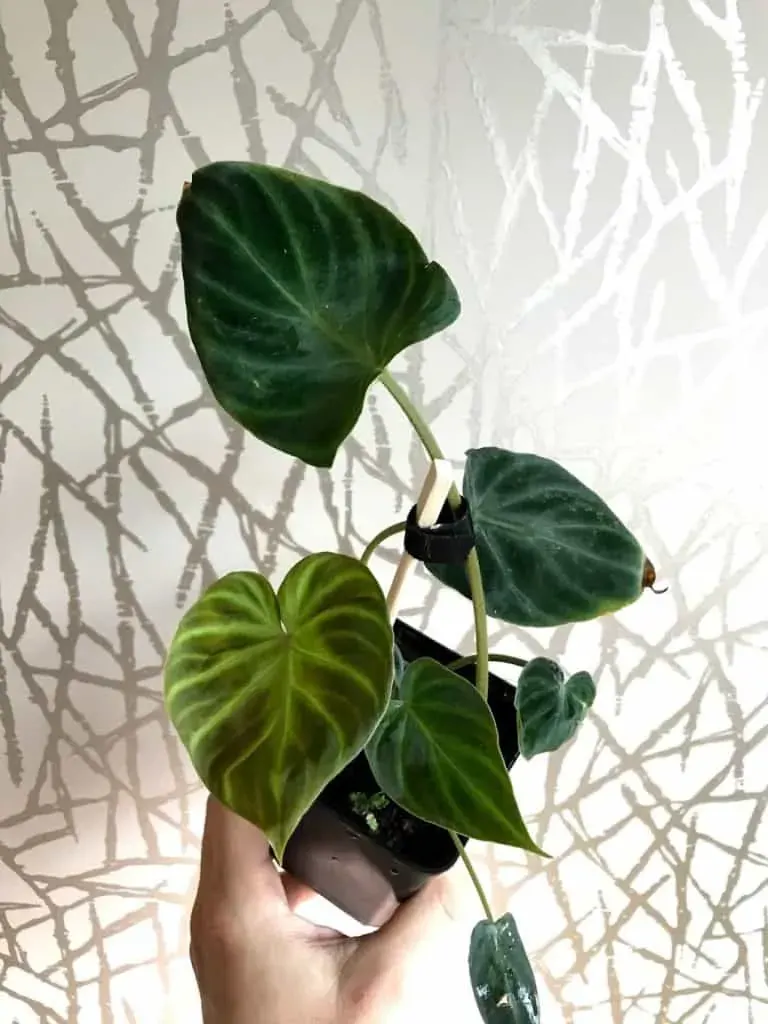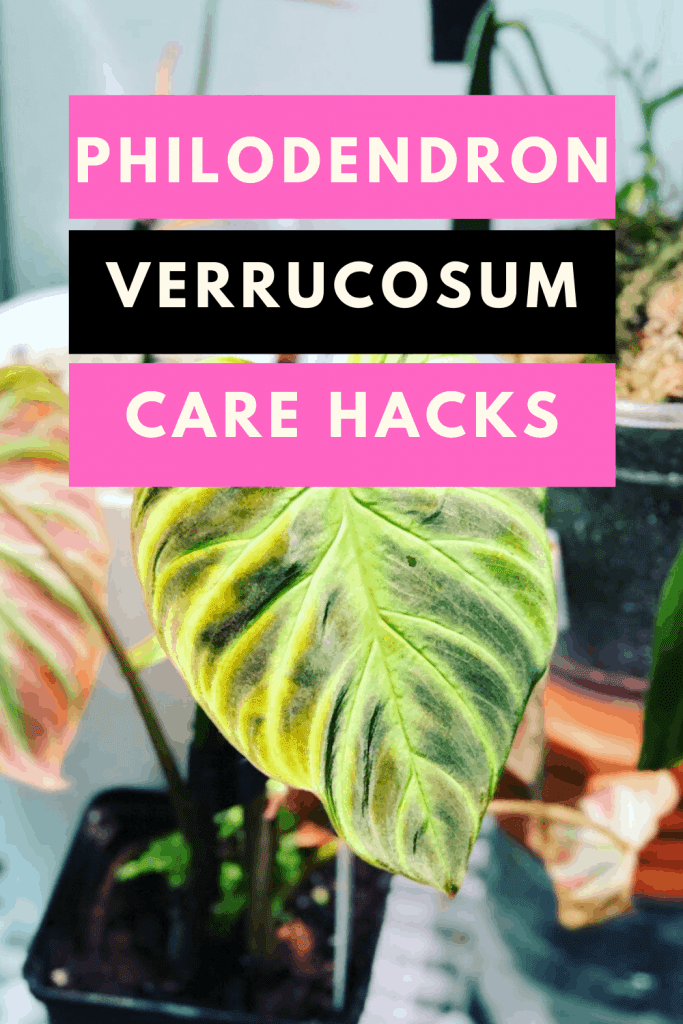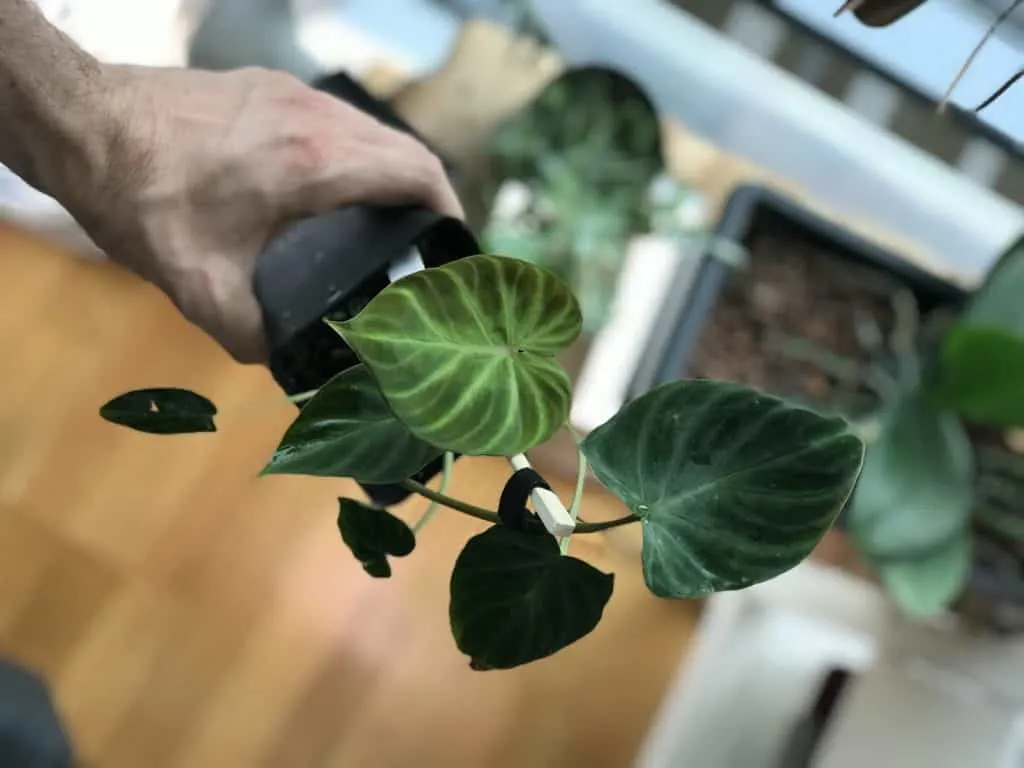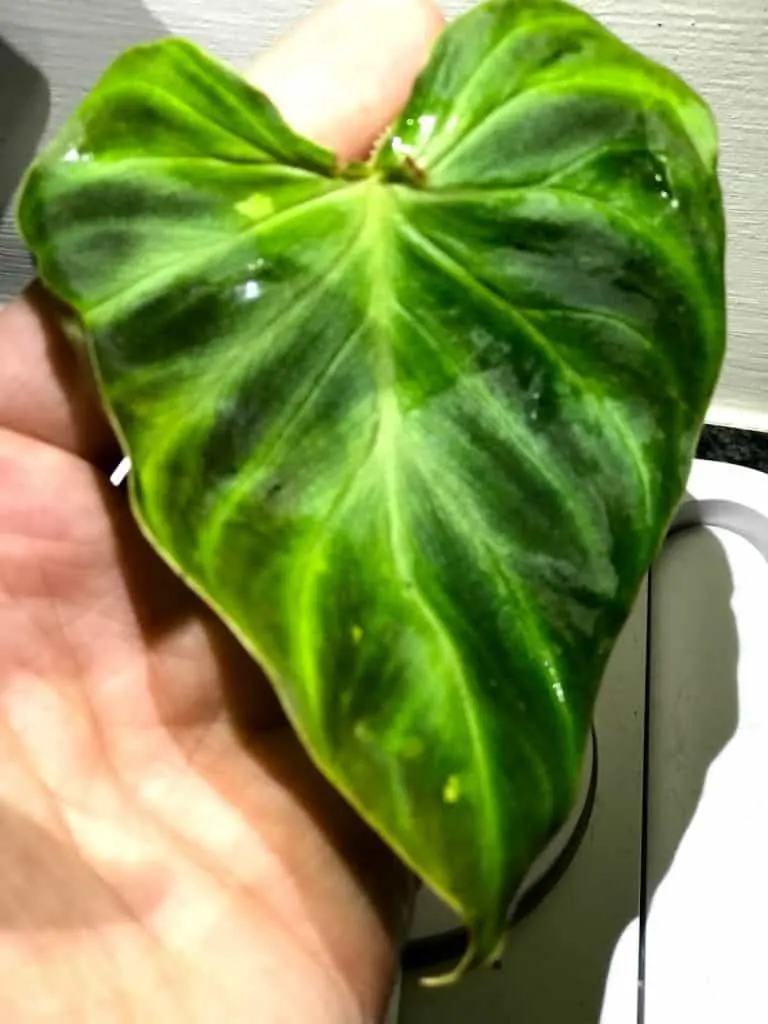You came to this article because you want to know more about the Philodendron verrucosum and Philodendron Verrucosum care. I have had multiple Blushing Philodendrons in my care for numerous years already. The Verrucosums are difficult to care for, but you will learn everything you need to know in my extensive guide.

Philodendron verrucosum Takeaways
| Species | Philodendron verrucosum |
| Synonyms | Blushing Philodendron |
| Family | Araceae |
| Genus | Philodendron |
| Growth | Climbing plant |
| Height | 20 feet |
| Width | 1 feet |
| Soil | Well-draining chunky soil |
| Watering | Every 5 to 7 days |
| Light | Bright indirect |
| Temperature | 65 - 85°F |
| Humidity | 60 to 80% |
| Fertilizer | Fertilize once a month |
| Propagation | Stem cuttings, seeds |
Table of Contents
Philodendron verrucosum Plant
The Philo verrucosum is a colorful Philodendron with velvety leaves. According to the International Aroid Society, it is usually a hemiepiphyte that starts as a seed growing in the canopy of trees and eventually reaches the soil with its roots.
Verrucosum means warty. This is a reference to the petioles that are often hairy. But not all Verrucosum varieties have hairy stems.
A hemiepiphyte is a plant that grows at least for a part of its lifecycle as an epiphyte. Epiphytes are plants that are growing attached to other trees.
The Verru plant has many variants, but at least two distinct forms can be differentiated.
The Philodendron vericosum with red on the backside of the leaf blade and the variant with a green leaf backside.
Some of the Philodendron verrucosum have a hairy (pubescence) petiole, unlike the other heart-shaped species such as the Philodendron gloriosum or the Philodendron pastazanum.
The Philodendron verrucosum is a climber meaning that the growth habit is towards the sky and not along the surface.
The plant is native to Central to South America in Costa Rica, Nicaragua, Panama, Colombia, Ecuador, and Peru.
Philodendron verrucosum grows at an altitude between 165 to 6550 feet (50 – 2000m) above sea level and is, therefore very diverse in its needs.
Many websites describe Philodendron verrucosum as an easy-to-grow houseplant. I do not fully agree, as the humidity needs seem bigger than most other houseplants I have encountered.
In addition, leaves turn crisp and brown quite easily when your watering regime is not on point.
But do not worry. I have you covered with my in-depth Verrucosum Philodendron care guide.
Table of Contents
Philodendron Verrucosum Care Guide

What Soil is best for a Philodendron verrucosum?
The ideal soil for a Philodendron verrucosum is well-draining soil consisting of potting soil, orchid bark, perlite, and charcoal.
The right soil is so important, so I always discuss this topic first. Many problems arise because of the wrong potting soil, and stress is caused once your plants show signs of overwatering.
The right potting mix is even more important when dealing with plants in the Aracaea family, where many species are epiphytes.
Roots need aeration, meaning the possibility of direct airflow to the roots. This requirement can only be met if your potting mix is airy. Sufficient drainage is crucial.
For this to happen, you will need to have chunky ingredients, and that will allow for air pockets in-between the potting medium to form.
The following aroid mix I would like to share with you is working well for my Philodendron verrucosum:
- Potting Soil (30%)
- Orchid Bark (30%)
- Perlite (30%)
- Charcoal (10%)
Keep soil pH values between 5.1 to 6.0.
Philodendron verrucosum Light
Bright indirect light or filtered light is best for the Blushing Philodendron. With indirect lighting, I mean light from a window that does not touch the leaf blades directly.
These conditions can be best met in an east-facing window where the indoor plants get bright indirect light for a big part of the day and some direct sunlight in the morning.
I wrote an extensive article about sunlight and window directions that you can check out here.
How to water a Philodendron verrucosum?
Water about once every 7 days. Water thoroughly when watering to mimic tropical jungle conditions. It is best practice to keep the soil humid but never soggy.
Also, do not let the soil of your P. verrucosum dry out completely, as it is often suggested in plant care guides.
The dry soil will act as a shield due to the blanket effect and might prevent humidity from getting to the roots.
With the right substrate, you should be able to keep your plant’s roots healthy and water the plant plenty when you are watering.
Root rot is a common cause of improper soil conditions and an inadequate watering schedule. You can read my article about preventing root rot if you want to know more about it.
What is the ideal Temperature for Philodendron verrucosum?
Philodendron verrucosum loves the temperature to be above 68°F (20°C). A temperature above 77°F (25°C) in combination with high humidity will ensure that your p. verrucosum is growing super fast if you have a verrucosum type that prefers warmer temperatures.
They can also be cold growers and grow better in lower temperatures. Remember that the Philodendron verrucosum is found at altitudes ranging from 165 to 6550 feet (50-2000m) above the sea.
You would meet these conditions in Central and South America where the Philodendron grows in nature.
The Philodendron verrucosum can be grown outside hardiness zones 9b-11 according to the United States Department of Agriculture’s hardiness zones. Make sure temperatures stay above 40 °F (4.5 °C).
What Humidity does P. verrucosum need?
High humidity above 60% is advised to keep your Philodendron verrucosum in great shape and growing vigorously.
After all, it is a subtropical to tropical plant that grows under humid conditions in the wild. I keep mine very humid, above 90% in terrarium conditions, and they thrive.
How often do I need to fertilize Philodendron verrucosum?
Fertilize away from the base monthly in spring and summer using liquid fertilizer. The best fertilizers to use are slow-release fertilizers or liquid fertilizers. Slow-release fertilizer can be applied 3-times a year.
This solid fertilizer comes as little sticks or colorful balls you put into the soil.
If you do not fertilize your Philodendron verrucosum it will grow very slowly.
My guide about nutrients and fertilizer has you covered if you want to know more about fertilizer best practices.
Philodendron verrucosum Propagation
The Philodendron verrucosum can be propagated using stem cuttings, seeds, and air layering.
Philodendron verrucosum cutting
Stem cuttings commonly propagate Philodendron, such as Philodendron Selloum, Philodendron Gloriosum, or Philodendron Birkin.
Step-by-Step Philodendron verrucosum propagation:
- Chose a section of your plant that is viable for propagation
- Make sure that the section you are choosing has at least one node
- Prepare your pruning shears, scissors, or knife ready by holding them under a flame for a few seconds and using rubbing alcohol.
- Use the now disinfected blade(s) to make a clear cut
- Put cinnamon on the wounds. This will help them to heal faster and to get not infected.
- Put the Philodendron verrucosum cutting in Sphagnum Moss. Viable alternatives are water, perlite, or soil directly.
- Before using the Spaghnum moss, put it in water and press it in your fist at least three times for excess water to drain.
- Now the humidity of your moss is optimal.
- Put the cutting with the Sphagnum Moss in a jar or pot
- Ensure the spot you choose provides warmth and humidity to your cutting, speeding up the process.
After 3 to 4 weeks, you should see roots emerging. However, it can go much faster or much longer or be unsuccessful.
Many variables will affect your success rate. Apart from temperature and humidity, a big factor is choosing the right season for cuttings and propagation attempts.
Spring and Summer are generally the best seasons for propagating houseplants or plants.
Air Layering
A different method is to air-layer your plant. This is the process of getting roots from your future cutting before you cut it.
You put Sphagnum moss around a node with air roots and cover it with plastic. After a couple of weeks, roots should start growing.
Once the root length is sufficient, you can conduct your cut and get a rooted cutting. The success with this method is higher as you get a cutting with roots.
However, the process is a bit more difficult to do as fixating the Sphagnum moss on the stem of your plant can be a little finicky for the beginner.
Philo Verrucosum Seeds
Propagating from seeds is a great method to get multiple plants. The biggest challenge is to acquire any seeds. Aroid seeds are hard to get, and some are quickly degenerating.
Buying seeds on the internet mostly is not a good idea as you could be sold anything but Philodendron verrucosum seeds.
The best way would be to own two plants so one can pollinate the other. For this to happen, both would either have to bloom simultaneously, or you would have to freeze the seeds of one plant and have it ready once the other blooms.
You may see by now why I am not going into further details here.
Apart from propagating this plant, which is fun, you may also have to deal with certain problems when things do not go well.
Let’s move on and put the spotlight on the most common problems with the Philodendron verrucosum.
Philo Verru Growth

These plants grow up to 3 feet or (90cm) in height. The Philodendron verrucosum leaves can reach a massive size of up to 3 feet or 36 inches (90cm).
New leaves emerge from deciduous cataphylls. Deciduous means that the cataphylls will be shredded off.
Philodendron verrucosum Moss Pole
Since the Verrucosum is a climber, it is best to provide a moss pole.
The moss pole will help the plant to gain height. Other effects of providing a pole are that the stem of the verrucosum will grow thicker, and the leaf size will increase considerably.
Without the possibility of climbing, it will take much longer for the Philodendron verrucosum to reach maturity, or it might even never reach this stage.
These plants grow better in winter if you have a verrucosum that is a cold grower.
Potting
P. verrucosum love to grow extensive root systems, so my suggestion is to not underpot this one.
Chose a pot size where the plant has sufficient space to grow a large root system.
You can use clay pots. A big advantage is that these will drain excess water from the soil. However, this also means that you have to water more frequently.
Read my article about the advantages of clay pots if you want the perfect pot for your plant.
Repot every 1-2 years just before your Philodendron becomes pot-bound.
A good choice if these plants are not grown in a terrarium is to provide a pebble tray underneath and fill it with water.
This will increase the humidity around the verrucosum plant.
Let’s not have a look at how you propagate this stunner.
Philodendron verrucosum mature
Philodendron verrucosum matures within 2-3 years. When Philodendron verrucosum grows, the leaves often get larger, and the veining is less pronounced. You can speed up the maturing process by providing a moss pole or a different structure that the verrucosum can hold onto with its aerial roots.
Philodendron verrucosum problems

Yellow Leaves on Philodendron verrucosum
Yellow leaves, if not seen on older leaves at the bottom of your plant, where it can be natural, is almost always a clear sign of overwatering.
Take it as a warning signal, and decrease the frequency you water your Philodendron verrucosum.
If the soil has been soggy for a long, you might also have to check the roots for root rot symptoms.
Verrucosum Drooping Leaves
This can be a confusing one as drooping leaves are an indicator of two contradictory causes.
Drooping leaves in Philodendron plants can either be a cause of overwatering or a cause of underwatering.
So the most important step here is to determine which one it is. Stick one of your fingers into the soil. If it feels soggy and a lot of soil stays on your finger once you pull it out of the soil you might be overwatering.
The opposite is true for underwatering. While underwatering can be corrected quickly by a good drench and a better-adjusted watering schedule based on your condition, overwatering needs several steps to be corrected.
If overwatering is the cause you may need to remove and exchange the soil completely. Chances are that root rot will start to emerge and that might also infest the soil.
Remove all the soil and disinfect the plant pot. I then advise using a better, more airy potting soil mix with chunky bits where aeration of the roots is granted.
Philodendron Verrucosum Root Rot
Root rot is a disease that can be caused by overwatering. It will cause rotting roots that die back. It will start to affect also health roots as this disease quickly spreads.
The cause is a lack of needed oxygen to the roots.
On the other hand, there also is a root rot fungus that can infect the roots of your Philodendron Verrucsoum and quickly spread to all of the roots of your plant.
Root rot is a serious disease that can kill your plant and needs to be identified and treated as quickly as possible.
Verrucosum Pest Infestation
Plant pests are the worst. They are often very nasty looking and hard to get rid of. The worst part is that they are mostly tiny, and you won’t even know exactly what infested your plant before it is almost too late.
Since I have written in-depth articles for all the common houseplant pests that could settle on your Philodendron verrucosum, I am going to list all the articles here for your convenience:
Instead of going into too much detail, I will also list the proven ways of getting rid of most pest infestations, as you may encounter one sooner or later:
Neem Oil– This oil works wonders against pests of all sorts. It isn’t cheap; you can get it either pure and mix it with water or premixed and ready to spray on your plant. It leaves an interesting scent that some people hate, and others might like.
But the most important part is that all the buggers hate it. Very effective but needs multiple applications to be effective.
Castile Soap – Use real soap, and you will be astonished to see that it can successfully fight a bug infestation on your Philodendron verrucosum. Mix one tablespoon of Castile soap and use 1 quart of water.
Rubbing Alcohol – Dilute rubbing alcohol with water and use a cloth or Q-tip to clean your Philodendron Verrucosum. Use 1/2 cup of rubbing alcohol with 1 quart of water.
My latest discovery is predator bugs. These are bugs that eat other bugs you don’t want to have on your plants.
I am currently experimenting with lacewing larvae, as they do not fly until adults and are very effective in eliminating multiple plant pests. Highly recommended.
With all the described methods, please remember that you need to make multiple applications, and you will have to repeat the process after 2-3 weeks as plant pests might lay eggs above and underground that will hatch during that period.
So once you fought the first batch successfully, the second batch might already be hatching and ready for wave 2.
Tips to keep Philodendron Verrucosum problem-free
In this section, I want to take the chance to highlight the most important tips and tricks to keep your Philodendron Verrucosum happy and growing well:
- Keep the humidity as high as possible. Whenever the humidity was low, I ran into problems with this plant. This does not come as a surprise since they are growing in natural cloud forests.
- As a hemiepiphyte, these plants need a very airy potting mix where air can reach the roots of your Philodendron Verrucosum
- Since most of these plants are cold growers, ensure temperatures are not too high but moderate.
Philodendron verrucosum types
1. Philodendron verrucosum Incensi
Philodendron verrucosum Incensi is a popular verrucosum with a red leaf backside and green to yellow stripes on the leaf upperside. The leaves are dark green and velvety.
2. Philodendron verrucosum Amazon Sunset
The Philodendron verrucosum Amazon Sunset has a very deep red backside comparable to the Philodendron El Choco Red.
3. Philodendron verrucosum Tambillo
The Philodendron verrucosum Tambillo has an irredescent shine on the adaxial leaf blade. The pattern and veining are bright and resemble lighting bolts on the green leaves.
4. Philodendron verrucosum Panther
Philodendron verrucosum Panther is a fast growign verrucosum with different green coloring. The green is a darker green compared to other varieties.
5. Philodendron verrucosum Esmeralda
Philodendron verrucosum Esmeralda was collected in the Esmeralad region, as the name suggests. The leaves are rounded with a red backside. The veining on the adaxial side of the leaf shines through the abaxial side.
6. Philodendron verrucosum Bosco
Philodendron verrucosum Bosco i a rare Verru. It has hairy petioles.
7. Philodendron verrucosum Red Back
The Philodendron verrucosum Red Back produces green leaves with red backsides. The green on the leaves intensifies as the leaves grow and mature.
8. Philodendron verrucosum Rojo
Philodendron verrucosum Rojo is yet another verrucosum with an intense red leaf underside.
9.Philodendron verrucosum Fantasy
The Philodendron verrucosum Fantasy has very hairy petioles and cataphylls. The back of the leaves has a burgundy red color.
10. Philodendron verrucosum Mini
Philodendron verrucosum Mini is a miniature form of Philodendron verrucosum that grows smaller leaves and stays much smaller. These plants are ideal for a terrarium.
11. Philodendron verrucosum Titanium
Philodendron verrucosum Titanium has dark velvety leaves. It is also known as Philodendron Ecuador and has slightly hairy petioles.
12. Philodendron verrucosum Hummingbird
The Philodendron verrucosum Hummingbird looks like the Philodendron Amazon Sunset. The main different are teh abaxial leaf side that is not fully red on the Philodendron verrucosum Hummingbird.
13. Philodendron verrucosum Cobra
The Philodendron verrucosum Cobra has irridescent leaves and intense white to yellow markings and veining on the adaxial leaf blade. This one has dark green leaves comparable to a Philodendron gloriosum.
14. Philodendron verrucosum Black
Philodendron verrucosum Black or Philodendron verrucosum Dark Form has velvety dark green leaves. They are not entirely black but much darker than the common form.
Philodendron verrucosum Crosses
Some rare Philodendron verrucosum crosses are:
- Philodendron verrucosum x Philodendron melanochrysum (Philodendron Splendid)
- Philodendron verrucosum x Philodendron gloriosum (Philodendron Glorious)
Frequently Asked Questions
Why are the leaves of my Philodendron Verrucosum drooping?
Drooping leaves can be a sign of underwatering but also of overwatering. The most common reason is underwatering.
How to care for a Philodendron Verrucosum?
These plants love high humidity, bright indirect light, and moderate temperatures. Loose, airy soil is necessary as the Philodendron verrucosum is a hemiepiphyte, growing at least part of its life on other trees. Keep the soil moist but never soggy, and water frequently.
Is Philodendron Verrucosum a fast grower?
Most philodendron grows best in autumn to winter when the temperatures are cooler as it is mostly a cold grower. Philodendron verrucosum grows in cloud forests at elevations up to 6550 feet (2000m).
What family does the Philodendron Verrucosum belong to?
Philodendron verrucosum belongs to the Araceae family, as does the Monstera genus.
Conclusion
Philodendron Verrucosum is a stunningly beautiful aroid with velvety leaves, striking leaf blades, and interesting petioles.
If you can offer proper conditions for this stunning Pihlodendron to thrive, it will pay you back a thousandfold with its iridescent leaves and red to purple backs (this is at least true for some verrucosum types).
We can conclude that verrucosum is mostly a cold grower that loves and needs high humidity and loose, airy soil to flourish.
What is your experience with growing Philodendron Verrucosum?

Daniel has been a plant enthusiast for over 20 years. He owns hundreds of houseplants and prepares for the chili growing seasons yearly with great anticipation. His favorite plants are plant species in the Araceae family, such as Monstera, Philodendron, and Anthurium. He also loves gardening and is growing hot peppers, tomatoes, and many more vegetables.


